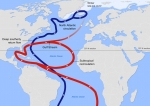09/08/2019
The Last Fight, 4: Global warming
While many observers consider global warming a terrible threat, it only stands at the fourth rank. We all know the most visible part of global warming, which includes more and stronger storms, more powerful hurricanes, unbalanced weather, heat and cold waves, as all these have already turned up. We are less familiar with the lesser-known diluvian rainfalls leading to extensive floods and landslides. Many of us will discover that, over formerly temperate weather countries, long and sustained rain leads to destabilizing of many land masses, and even gentle slopes will be enough to turn parts of our cities into catastrophes. Large rivers such as the Mississippi or the Yang Tse, currently extremely useful for transportation and commerce, will turn into nightmares, to the point where their surroundings will have to be deserted. This translates into abandoning most of Louisiana riverside harbors, Nanjing and Shanghai, and now this means trillion dollars. Landslides will not only affect cities, but also farming territories such as paddy fields.
Global warming also raises the level of the seas (slowly), and changes the age-long path of hurricanes (faster): the western coasts of China and the USA will be hit by hurricanes coming stronger and further north. While Miami Beach may be the first officially abandoned city, Shanghai, threatened by region-w

ide floods, repeated hurricanes and ocean rise will be the most spectacular, and certainly the costliest abandoned city, even New York will not come close. All three cities will be abandoned before the end of the century; we might defend them against the fury of the oceans, but moving inside will prove less costly, as oceans will keep raising well into the 22nd century.
The second aspect of global warming, which we only begin to see (2015), is the rise of sicknesses coming from the tropical areas towards the (currently) temperate northern areas. While Americans already have discovered the West Nile virus and the avian flu, many other sicknesses will follow, which have similar vectors (mosquitoes, birds, etc.). When the temperature rises by 3°C, the northern limit of malaria in Europe will be London; we have no cure for most of these not-so-new sicknesses. Adults do not die from malaria, it may happen to babies or old people. Still, a fit of malaria will have the patient disabled for a week; this will directly impact the cost of working.
Animals will face similar problems, with unheard-of epidemics; so much so that in some cases, intensive production of meat will be so problematic that it will have to be banned in southern states, setting suddenly very high prices to formerly cheap food such as chicken or pork.
The third side of global warming is positive feedback. This friendly term hides the most catastrophic consequence of global warming, which is reaching the point where the self regulated weather we currently enjoy loses all balance, and a new geologic or biologic reaction will actually accelerate global warling. We all heard about the immense permafrost plains in Siberia and Canada, where large amounts of green effect gases (methane) are currently trapped in ice-like formations. When this permafrost starts thawing, large amounts of methane will be released into the atmosphere, giving an added acceleration to global warming. A first report shows that thawing already has started (2019) in the Canadian Arctic, decades in advance over the latest predictions.
 Europeans enjoy temperate weather in spite of being at the same latitudes as Canada, all thanks to the Gulf Stream, nowadays called the North-Atlantic drift (map: BBC). This drift is made of the warm Gulf of Mexico waters, coming north, bringing their heat to Europe. When reaching the arctic, these waters cool down, becoming more dense, “fall” to the bottom of the sea because of their higher density and return south. This “polar conveyor belt” only exists because of the high temperature difference between tropical and arctic waters, and researchers had computed that the N-A drift might slow down if and when the polar ice cap would disappear, thus letting the Arctic waters to warm up. A recent study (2018) showed that the drift has slowed down indeed already; if this study is confirmed, Western Europe will get a weather similar to the Maine’s by the end of the century. Its agriculture will be a shambles, and nearly half its housings will need rebuilding.
Europeans enjoy temperate weather in spite of being at the same latitudes as Canada, all thanks to the Gulf Stream, nowadays called the North-Atlantic drift (map: BBC). This drift is made of the warm Gulf of Mexico waters, coming north, bringing their heat to Europe. When reaching the arctic, these waters cool down, becoming more dense, “fall” to the bottom of the sea because of their higher density and return south. This “polar conveyor belt” only exists because of the high temperature difference between tropical and arctic waters, and researchers had computed that the N-A drift might slow down if and when the polar ice cap would disappear, thus letting the Arctic waters to warm up. A recent study (2018) showed that the drift has slowed down indeed already; if this study is confirmed, Western Europe will get a weather similar to the Maine’s by the end of the century. Its agriculture will be a shambles, and nearly half its housings will need rebuilding.
12:53 Publié dans Il n'y a plus d'espoir | Lien permanent | Commentaires (0) |  |
|  del.icio.us |
del.icio.us |  |
|  Digg |
Digg | ![]() Facebook |
Facebook |










Les commentaires sont fermés.